-

-
We are specialists for your holidays in La Palma. With personalized assistance on-site.

Ulrich & Evelyn Roth -
Our service numbers
Write e-mail+34 822 68 00 89
+49 7442 819 85 90
We're available from Monday to Friday from 10:00 a.m. to 6:00 p.m., and Saturdays from 10:00 a.m. to 1:00 p.m.
-
Accommodations
- with pool 90
- on the seaside 42
- with internet 205
-
Northwest >>
130
- Aguatavar 7
- Arecida 6
- El Castillo 1
- Garafía 4
- Las Tricias 7
- Puntagorda 42
- Tijarafe 22
- Tijarafe Costa 6
- Tijarafe El Jesús 12
- Tijarafe La Punta 21
- Tinizara 2
-
Aridane Valley >>
225
- Celta 7
- Charco Verde 3
- El Paso 23
- Hermosilla 1
- La Bombilla 2
- La Laguna 11
- Las Manchas 24
- Las Norias 11
- Los Llanos de Aridane 25
- Puerto de Naos 45
- San Nicolas 8
- Tacande 2
- Tajuya 9
- Tazacorte Costa 5
- Tazacorte Puerto 14
- Tazacorte Villa 23
- Todoque 12
-
South >>
31
- Fuencaliente 7
- Las Indias 4
- Lomo Oscuro 1
- Los Quemados 6
- Salemera 2
- Tigalate 2
- Villa de Mazo 9
- East >> 16
-
Northeast >>
5
- Barlovento 2
- Los Sauces 2
- Puntallana 1
Monarch Butterfly on La Palma
Conservation of Species
"monarca"
Monarch Butterfly
Danaus plexippus
The Monarch Butterfly is threatened with extinction. Already existing for millions of years, the monarch butterfly cannot survive without milkweed (Asclepia) whose leaves are the butterfly's unique source of food, for which La Palma offers excellent climate conditions.
Danaus plexippus

The largest existing butterfly species on the Canary Islands is the magnificent American Monarch (Danaus plexippus).
Monarch Butterfly exist for millions of years. They likely came from the mountains and valleys of Mexico and Central America and in the course of time spread over warmer northern regions.
In search of the milkweed, Asclepia, which are needed to feed caterpillars, they even came to Canada.
The Migration Journey - A Miracle of Nature

By the end of summer the fantastic migration spectacle takes place in North America.
Millions of Monarch Butterflies swarm in masses and set out to their journey to their winter homes in Mexico.
The Canadian butterfly exlorer Fred Urquhart started his search for those wintering areas in 1938.

Almost 40 years passed tagging butterflies with the help of his wife and throusands of volunteer helpers and watching out for them. Finally, in 1975 the butterflies were found again in the Sierra Nevada in Mexico.
In huge colonies they were attached to a 3000 m high Oyamele Fir Forest. Many butterflies have covered a distance of 3000 up to 4000km.
In February Februar, when temperatures increase, Monarch Butterflies wake up from hibernation.
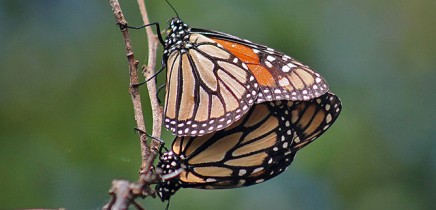
They mate and swarm in orange- coloured clouds back towards north. This journey is usually based on generations, as usually butterflies die within 2 up to 6 weeks.
Only the ones that hatched lately in summer undertake the huge migration. That's how young butterflies mysteriously reach the unknown birthplaces of their ancestors.
Endangered Monarch Butterfly

During the last years the number of monarch butterflies has drastically decreased. In their American habitat the life-essential and wild growing milkweed is more and more disappearing. Which is also where they lay their eggs and caterpillars only feed from their leaves.
Illegal deforestation of the Oyamel Fir Trees in Mexico, the use of pesticides and intensive monocultures threaten the survival of the precious butterfly.
The "International Union for Conservation of Nature" (UICN) rates the migration of the Monarch Butterfly as in danger of extinction.
But how can we help? - By providing this unique butterfly its living environment.
Monarch butterfly colonies also exist in Australia and New Zealand. In Europe we find them on the Azores, on Madeira, in West Europe and on the Canary Islands.
And how are things on La Palma?
On the island La Palma you can observe the Monarch Butterfly almost year-round.
From May to November it can be seen around the entire island, while during the winter months it mainly stays in the southern parts and you can watch them fluttering through Santa Cruz, Puerto Naos or Tazacorte.
Holiday House Casa Monarca in Las Manchas

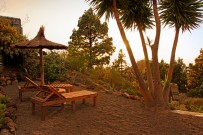 A wonderful possibility to live closely with Monarch Butterflies is the Holiday House Casa Monarca in Las Manchas on the west side of La Palma.
A wonderful possibility to live closely with Monarch Butterflies is the Holiday House Casa Monarca in Las Manchas on the west side of La Palma.
This 100% sustainable designed and energy-self-sufficient Holiday House is a unique opportunity to witness how the butterflies visit the milkweed plants in the garden.

The 1-bedroom Holiday House for 2 persons (+ 1 baby) is nestled on a 3,500 m2 property with a large fruit orchard.

A combination of solar and wind energy fully covers the electricity demand.
The interior of the Casa Monarca features a very homely and cosy living area with a fireplace and a separate kitchen. You also enjoy a gorgeous panoramic view of the Atlantic Ocean.
Meanwhile, there are a large number of butterfly lovers on the island growing Asclepias in their gardens.
This is where the entire Butterfly Cycle takes place

The female, attracted by the smell and colour of the plants, lays a large number of eggs on the bottom side of the leaf.
After 4-7 days tiny caterpillars hatch. As soon as they fed themselves well on the leaves, not only food but also a small dosage of herbicide, that protects them from natural enemies, they crawl on the upper leaf surface.
This whets their appetite for more.
In the following 9-16 days the black-white-yellow ringed caterpillar sheds its skin for four times.
Their forage plant becomes more and more bare and sometimes they even eat the stem. Butterfly lovers should grow sufficient milkweed plants in order to prevent the caterpillars from starving and provide enough plants for the females to lay their eggs.
 Once the caterpillars are about 6cm, they choose a proper space fo their pupation.
Once the caterpillars are about 6cm, they choose a proper space fo their pupation.
This may be on the same plant, below a table or a on a blade of grass.

For this purpose they hang upside-down on a silk-like thread, shaping a "J". In this positon they remain 12 up to 16 hours to shed their skin for the very last time.
It transforms into a pretty green chrysalis with golden shimmering dots.
Little by little their wrap becomes darker and more transparent.
About 8 to 13 days later you already recognize the orange colour of their wings. Depending on the weather conditions 4 to 7 weeks have passed before the butterfly emerges from its chrysalis.
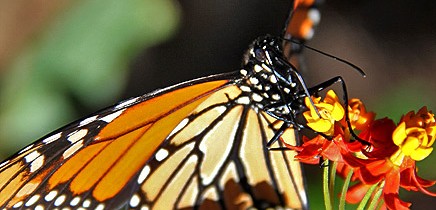
Now the Monarch Butterfly needs some time to stretch out its sensible wings and dry, before taking its first flight. Its wingspan can range up to 12cm and its weight is less than 1 gram.
And it will not be part of the large migration journey to Mexico, however La Palma offers everything it needs - provided that we all give a helping hand.


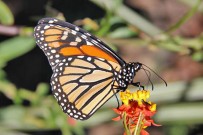


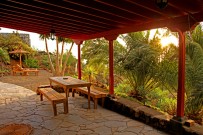

Sehr schöner bericht .... DAS alles erlebe ich zur zeit .... da sind wirklich kleine "freßmaschinen" am werk, einige Raupen sind nun geschlüpft, das zu erleben, hat mich sehr beeindruckt. .... doch komme ich leider nicht hinterher, neue Seidenpflanzen zu kaufen
Juni 2024, bei mir in Triana habe ich ihre Entwicklung über die einzelnen Stdien beobachten können.
Bin auf Teneriffa. Meine Asklepiapflanzen wurden schon weggefuttert. Jetzt fressen sie meine Frangipanis. Scheint eine Art Ersatzfutter zu sein. Hab Fotos, falls Interesse besteht. Hab auch die Paarung gefilmt.
Wir haben in der Casa Monarca im Februar 2018 eine wunderbare Zeit verbracht und dieses ökologisch durchdachte Refugium als mustergültig für nachhaltigen Tourismus erachtet. Damals ahnten wir nicht, dass heute nur wenige hundert Meter von diesem idyllischen Ort einmal der Krater des 2021 ausgebrochenen Vulkans Tajogaite liegen würde und dieser wunderbare Platz unter dutzenden Metern Lava verschwinden ist. Gleichzeitig eine schauderhaft schöne Demonstration, welche Transformationen mit geologischer Urgewalt in einer Landschaft wie auf La Palma stattfinden können. Gerne würden wir wissen, wie es Manolo und seiner Frau heute geht und wir hoffen sehr, dass sie diesen Schlag irgendwie verkraften konnten. Wenn es ein ähnliches Feriendomizil gibt, dass wir durch unseren Besuch in Zukunft unterstützen können, dann würden wir uns über eine Rückmeldung freuen. Martin und Katrin P.S.: dürfte gerne wie die Casa Monarca etwas einsam und abseits liegen um bei dunklem Nachthimmel der Astronomie fröhnen zu können...
Eine umfassende und fesselnde Beschreibung, versehen mit tollen Bildern. Vielen Dank.